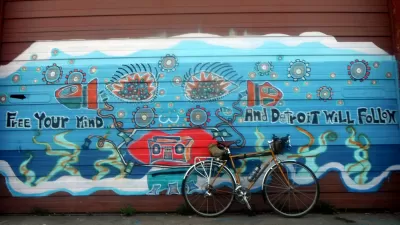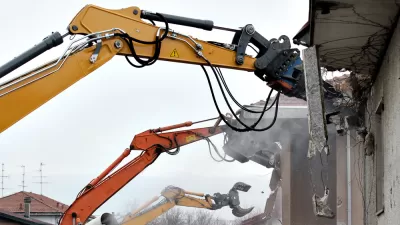For cities across the U.S. facing mass foreclosures and shrinking populations, demolition of abandoned homes is an attractive avenue (see Detroit and Cleveland). Roberta Brandes Gratz argues that the value of preservation deserves to be considered.
Inspired by Cincinnati Mayor Mark Mallory's speech at last month's Reclaiming Vacant Properties conference in New Orleans, Gratz argues that historic preservation deserves to be considered by so-called "shrinking cities" as they consider ways to stabilize population losses and encourage new investment. According to Gratz, Mallory "prefers working with community-based groups that renovate empty
properties and put people back in homes," rather than tearing down abandoned buildings. "When you keep
clearing land," said Mallory, "it makes it difficult to get new investment and kill the
chance to repopulate."
And, apparently, the findings of a new report, "Historic Preservation and Rightsizing" [PDF], commissioned by the Advisory Council on Historic Preservation, back Mallory up.
In the cities losing population studied by Don Rypkema and Cara Bertron of Place Economics, "they found the least
shrinkage in places where preservation is made a priority over
demolition; sometimes renewed population growth occurred. They compared
the rate of population change between 2000 and 2010 in the 20 cities
with the highest proportional population loss. By overlaying historic
district maps on census tracts, they found that historic districts
either 'lost less or grew more when the larger city lost population,'
Rypkema said."
"Preservation is one of the most potent tools for city revitalization," concludes Gratz. "That message should not get lost amid worries about city shrinkage."
FULL STORY: In Shrinking Cities, Preserving Existing Buildings Can Stem The Loss

Planetizen Federal Action Tracker
A weekly monitor of how Trump’s orders and actions are impacting planners and planning in America.

Map: Where Senate Republicans Want to Sell Your Public Lands
For public land advocates, the Senate Republicans’ proposal to sell millions of acres of public land in the West is “the biggest fight of their careers.”

Restaurant Patios Were a Pandemic Win — Why Were They so Hard to Keep?
Social distancing requirements and changes in travel patterns prompted cities to pilot new uses for street and sidewalk space. Then it got complicated.

Platform Pilsner: Vancouver Transit Agency Releases... a Beer?
TransLink will receive a portion of every sale of the four-pack.

Toronto Weighs Cheaper Transit, Parking Hikes for Major Events
Special event rates would take effect during large festivals, sports games and concerts to ‘discourage driving, manage congestion and free up space for transit.”

Berlin to Consider Car-Free Zone Larger Than Manhattan
The area bound by the 22-mile Ringbahn would still allow 12 uses of a private automobile per year per person, and several other exemptions.
Urban Design for Planners 1: Software Tools
This six-course series explores essential urban design concepts using open source software and equips planners with the tools they need to participate fully in the urban design process.
Planning for Universal Design
Learn the tools for implementing Universal Design in planning regulations.
Heyer Gruel & Associates PA
JM Goldson LLC
Custer County Colorado
City of Camden Redevelopment Agency
City of Astoria
Transportation Research & Education Center (TREC) at Portland State University
Camden Redevelopment Agency
City of Claremont
Municipality of Princeton (NJ)





























